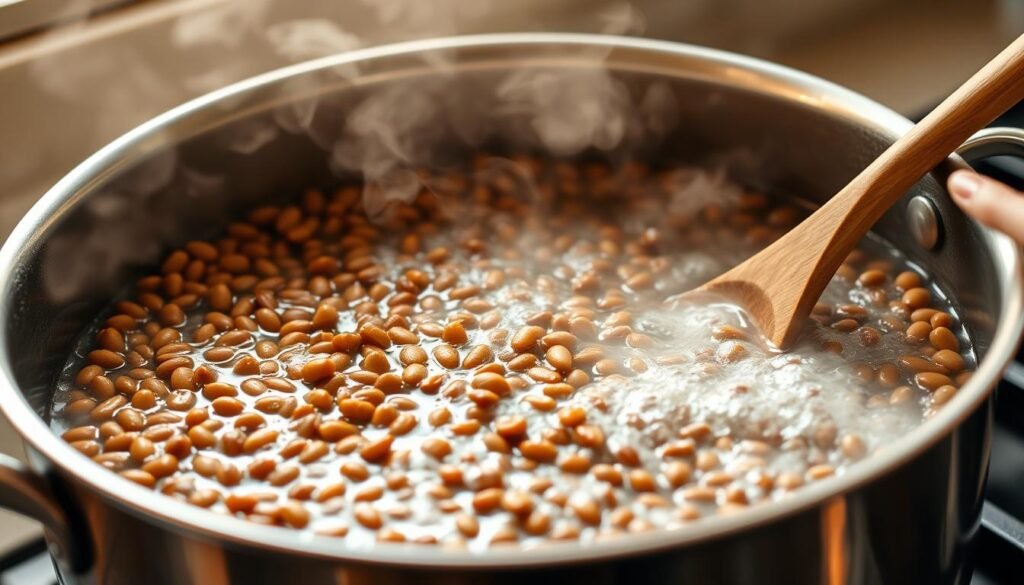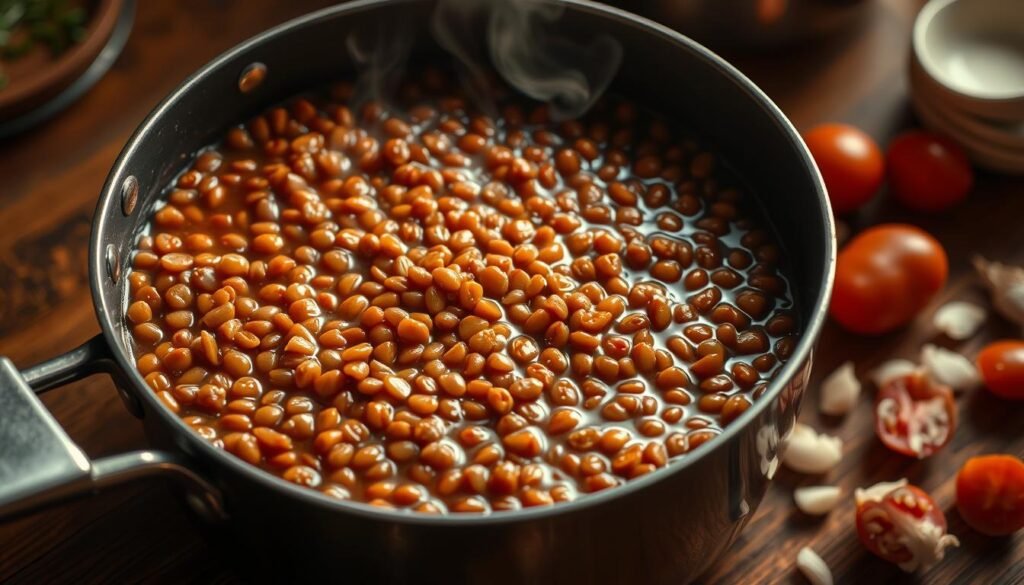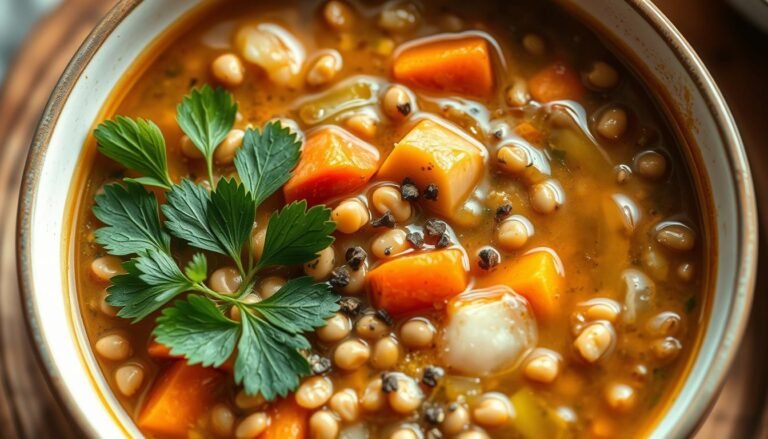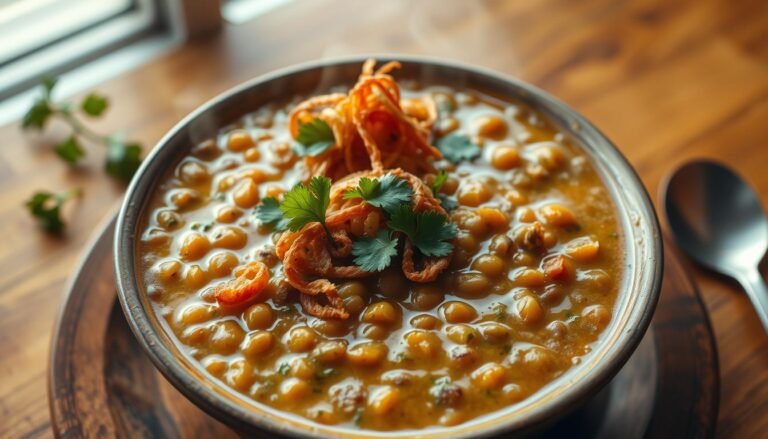Lentils are a nutritious and versatile food option, rich in protein and fibre. They’re an excellent addition to various meals, from salads to side dishes.
Cooking lentils can be straightforward when you know the right techniques. Different types of lentils have unique textures and cooking requirements. Understanding these differences is key to preparing them perfectly.
With the right approach, you can enjoy delicious and healthy lentil dishes every time. This guide will walk you through the process, providing tips tailored to the type and texture of lentils you’re using.
Key Takeaways
- Cooking lentils requires understanding their type and texture.
- Lentils are a nutritious addition to various meals.
- Different cooking techniques can enhance the flavour and texture of lentils.
- Properly cooked lentils can be used in a range of dishes.
- Lentils are a versatile ingredient for healthy eating.
Understanding Lentils: Types, Nutrition and Benefits
Lentils have been a cornerstone of healthy eating for centuries, providing a wealth of benefits. They are a versatile ingredient, available in various types, each with its unique characteristics and uses in different recipes.
Common Lentil Varieties Available in Australia
In Australia, you can commonly find several types of lentils, including red, green, brown, and black lentils. Red lentils are known for their quick cooking time and are often used in soups and curries. Green and brown lentils retain their shape after cooking, making them ideal for salads and side dishes.
Nutritional Profile and Health Benefits
Lentils are not only versatile but also packed with nutrients. They are an excellent source of protein, fiber, and minerals like iron and potassium. Incorporating lentils into your diet can help lower cholesterol levels and improve heart health.
Why Aussies Should Eat More Lentils
For Australians, adding lentils to their diet can provide numerous health benefits, from weight management to improved digestion. Lentils are also a sustainable food choice, requiring less water to cultivate compared to many other protein sources.
By understanding the different types of lentils and their nutritional benefits, Australians can make informed choices about incorporating these legumes into their meals, enhancing both their health and their culinary experiences.
Essential Preparation Before Cooking
Essential preparation is the foundation of cooking lentils to perfection. Before you start boiling lentils, there are several steps to follow to ensure they turn out just right.
Sorting and Rinsing Techniques
Begin by sorting through the lentils to remove any debris or shriveled lentils. Rinsing them in a fine mesh sieve is also crucial. This process helps in removing any impurities and ensures that your lentils cook evenly.

To Soak or Not to Soak: Guidelines by Lentil Type
Not all lentils require soaking. Generally, green and brown lentils don’t need soaking, while red lentils typically don’t require it either. However, soaking can reduce cooking time. It’s worth noting that some specialty lentils may benefit from soaking.
Measuring Perfect Lentil-to-Water Ratios
The ratio of lentils to water is crucial. Generally, a 2:1 water-to-lentil ratio is recommended, but this can vary depending on the desired consistency. For softer lentils, more water may be needed.
By following these preparation steps, you’ll be well on your way to cooking lentils perfectly every time.
How to Cook Lentils: The Fundamental Methods
Mastering the art of cooking lentils is simpler than you think, with methods ranging from traditional stovetop simmering to modern pressure cooking techniques. The key to perfectly cooked lentils lies in understanding the various cooking methods available.
Classic Stovetop Simmering
Stovetop simmering is a traditional and straightforward method for cooking lentils. It involves rinsing the lentils, then boiling them in water or broth, followed by a gentle simmer until they reach the desired tenderness. This method allows for a high degree of control over the cooking process, ensuring your lentils are cooked just right.
Pressure Cooker and Instant Pot Techniques
For those short on time, using a pressure cooker or Instant Pot can significantly reduce the cooking time for lentils. These appliances work by sealing the lentils and cooking liquid under high pressure, accelerating the cooking process. This method is not only quick but also energy-efficient, making it an excellent option for busy individuals.
Slow Cooker Approach for Busy Aussies
The slow cooker method is ideal for those who prefer a hands-off approach. Simply add rinsed lentils and your choice of liquid to the slow cooker, set it, and forget it. This method is perfect for busy Aussies who want to come home to a ready-to-eat meal. It’s also great for achieving tender lentils without constant monitoring.
Cooking lentils is a versatile process that can be adapted to suit various lifestyles and preferences. By understanding these fundamental methods, you can ensure perfectly cooked lentils every time.
Mastering Red Lentil Cooking
Cooking red lentils is a straightforward process that can elevate your meals with minimal effort. Red lentils, also known as split red lentils, are a popular choice in many Australian kitchens due to their quick cooking time and nutritional value.
Perfect Timing for Split Red Lentils
Split red lentils cook much more quickly than other lentil varieties. They become soft and tender after simmering for just 15-20 minutes. To achieve the perfect texture, it’s essential to monitor their cooking time closely.
Achieving Your Desired Texture: Firm to Creamy
The beauty of cooking red lentils lies in their versatility. You can achieve a range of textures from firm to creamy, depending on your preference. For a firmer texture, cook them for 15 minutes. For a creamier consistency, extend the cooking time to 25-30 minutes, adding more liquid as needed.

Australian-Style Red Lentil Soup Tips
Red lentil soup is a comforting and nutritious meal option. To give it an Australian twist, consider adding native ingredients like bush tomatoes or lemon myrtle. These unique flavors can enhance the dish, making it a delightful fusion of traditional and modern Australian cuisine.
For an extra creamy soup, blend a portion of the cooked lentils before adding them back to the pot. This technique helps to thicken the soup without compromising its flavor.
Green and Brown Lentil Cooking Guide
The art of cooking green and brown lentils lies in understanding their unique characteristics and cooking requirements. These lentils are known for their firmer texture compared to red lentils, making them ideal for salads, side dishes, and recipes where texture matters.
Precise Cooking Times for Different Textures
Cooking times for green and brown lentils can vary based on the desired texture. Generally, they take about 20-30 minutes to cook until tender but still firm. For a softer texture, cooking them for 35-40 minutes is recommended. It’s essential to check on them periodically to avoid overcooking.
Tip: For salads and side dishes, aim for a cooking time that leaves them slightly firm, as they’ll continue to cook a bit after draining.
Maintaining Firmness for Salads and Side Dishes
To maintain the firmness of green and brown lentils, avoid overcooking and rinse them with cold water after cooking to stop the cooking process. This technique is particularly useful when preparing lentil salads or side dishes where texture is crucial.
“The key to a great lentil salad is in the texture. You want your lentils to be cooked just right—tender but still with a bit of bite.”
Adding Flavour During the Cooking Process
Enhancing the flavour of green and brown lentils can be achieved by cooking them in vegetable or chicken stock instead of water. Adding aromatics like onions, garlic, and bay leaves during the cooking process can also significantly boost their flavour profile.
For an Australian twist, try adding native herbs like lemon myrtle or bush tomato to your lentil dishes for a unique flavour.
Black and Specialty Lentil Techniques
Cooking black and specialty lentils requires a nuanced approach to preserve their unique textures and flavors. These lentils, including Beluga and French lentils, are prized for their distinct characteristics and can elevate a variety of dishes.
Beluga and French Lentil Cooking Methods
Beluga lentils, named for their resemblance to caviar, and French lentils, known for their green color and delicate flavor, require careful cooking. To cook these lentils, start by rinsing them thoroughly, then boiling them in water or broth. The key is to cook them until they’re tender but still retain their shape.
Preserving Shape and Texture of Gourmet Varieties
To preserve the shape and texture of gourmet lentil varieties, it’s essential to monitor their cooking time closely. Generally, these lentils cook relatively quickly, typically within 20-30 minutes. Avoid overcooking, as it can lead to a mushy texture that’s undesirable in most recipes.
Pairing with Australian Ingredients
Australia’s diverse culinary scene offers numerous opportunities to pair specialty lentils with local ingredients. For example, combining Beluga lentils with bush tomatoes and lemon myrtle can create a dish that’s both uniquely Australian and flavorful. Experimenting with different ingredients can help you discover new favorite recipes.
As quoted by a renowned chef, “The art of cooking lentils lies in understanding their unique characteristics and leveraging them to create dishes that are both nourishing and delicious.” This quote encapsulates the essence of cooking black and specialty lentils, emphasizing the importance of technique and creativity.
“Using the right cooking technique can make all the difference when preparing specialty lentils.”
Troubleshooting Common Lentil Cooking Problems
Mastering the art of cooking lentils involves understanding how to troubleshoot common problems that arise during the cooking process. Whether you’re dealing with undercooked, overcooked, or flavorless lentils, there are simple solutions to rescue your dish. By addressing these issues, you can ensure that your lentil dishes turn out perfectly cooked and full of flavor every time.
Rescuing Undercooked Lentils
If your lentils aren’t fully cooked yet, simply retest every 1 to 2 minutes until they are tender. You can also add a bit more water or broth to help them cook further. Be cautious not to overcook them in the process.
Salvaging Overcooked or Mushy Results
Overcooked lentils can be salvaged by incorporating them into dishes where texture isn’t a priority, such as soups, stews, or curries. You can also try mashing them to create a lentil pâté or dip. Adding a splash of vinegar or lemon juice can help balance the flavor.
Fixing Flavour and Seasoning Issues
If your lentils lack flavor, try adding aromatics like onions, garlic, or ginger during the cooking process. You can also enhance the flavor with spices, herbs, or a bouillon cube. Seasoning at the end of cooking can also make a big difference. Experiment with different combinations to find what works best for you.
Storing and Using Cooked Lentils
Once you’ve mastered cooking lentils, the next step is learning how to store them effectively. Proper storage ensures that your cooked lentils remain fresh and ready for use in various recipes.
Refrigeration and Freezing Guidelines
Cooked lentils can be stored in the refrigerator for up to 4 to 5 days when kept in an airtight container. For longer storage, consider freezing them. Cooked lentils freeze well for up to 6 months. To freeze, spread the lentils on a baking sheet to cool, then transfer them to airtight containers or freezer bags. Label the containers with the date and contents.
| Storage Method | Duration | Tips |
|---|---|---|
| Refrigeration | 4-5 days | Store in airtight containers |
| Freezing | Up to 6 months | Cool completely before freezing; use airtight containers or freezer bags |
Meal Prep Tips for Weekly Lentil Dishes
Cooked lentils are perfect for meal prep. Prepare a large batch and use it throughout the week in different recipes. For example, use them in salads, stews, or as a protein substitute in dishes. For more ideas on incorporating lentils into your diet, check out this comprehensive guide on beans, peas, and lentils.
Reviving Leftover Lentils
If your leftover lentils have become dry, you can revive them by adding a little water or broth and reheating them. This simple trick can restore their texture, making them suitable for a variety of dishes.
Creative Ways to Use Perfectly Cooked Lentils
Perfectly cooked lentils are a versatile ingredient, opening up a world of culinary possibilities. With their rich nutritional profile and adaptability, lentils can be the star of various dishes, from comforting soups to vibrant salads.
Australian Fusion Lentil Recipes
Combining lentils with native Australian ingredients can result in unique fusion dishes. For instance, you can create a Moroccan-spiced lentil salad with roasted and raw carrots, or a hearty lentil and bush tomato stew. The key is to experiment with different flavors and ingredients to find your perfect blend.
Transforming Lentils into Family-Friendly Meals
Lentils can be a great addition to family meals, offering a nutritious and filling option. Try making lentil burgers or adding cooked lentils to your favorite pasta sauces. As Mark Sisson, a renowned food expert, once said,
“Lentils are an excellent source of protein and fiber, making them an ideal ingredient for family-friendly meals.”
You can also use lentils to make a comforting lentil soup that’s sure to please both kids and adults alike.
Lentil Substitutions in Traditional Aussie Dishes
Lentils can be used as a substitute in traditional Australian recipes, adding nutrition and texture. For example, you can use lentils instead of meat in a classic Aussie meat pie or as a topping for a veggie burger. This substitution not only enhances the nutritional value but also offers a delicious twist on familiar favorites.
By incorporating lentils into your cooking repertoire, you’ll not only be enjoying a versatile and nutritious ingredient but also exploring new flavors and recipes that can become family favorites.
Conclusion: Enjoying Your Lentil Cooking Mastery
Mastering the art of boiling lentils opens up a world of culinary possibilities. By understanding the different types of lentils and their unique cooking requirements, you can create a variety of delicious and nutritious dishes. Whether you’re simmering lentils on the stovetop or using a pressure cooker, the key to perfect lentil cooking lies in the balance of texture and flavor.
With the techniques and tips outlined in this guide, you’re now equipped to experiment with lentil cooking and incorporate this versatile ingredient into your daily meals. From hearty soups to flavorful salads, the possibilities are endless. So, get creative and enjoy the process of boiling lentils to perfection, exploring the rich flavors and textures that this simple legume has to offer.





